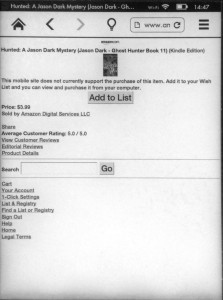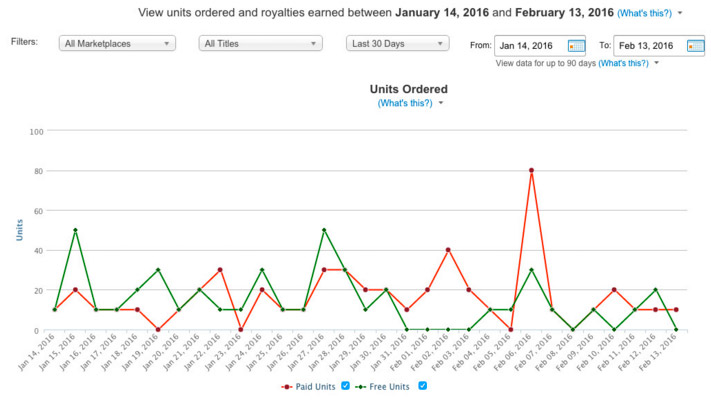Could Amazon do better with the Kindle?
The self-publishing process has matured significantly over the past eight years since I started, around the time when the Kindle first made an appearance. Information on the subject matter is more abundant and more readily available than ever while the tools to create books have also improved and become more widely available.
However, as I prepared the launch of my new book “Zen of eBook Marketing” these past weeks, I realized that despite a general maturation, Amazon’s Kindle Direct Publishing program still shows some serious shortcomings. Issues, that have plagued the platform since its inception.
As you may know, creating early exposure for an upcoming book is crucial for a successful launch. We all know that, and creating online promotions for books is an essential part of this process. It is here where, perhaps, the most glaring limitation in Amazon’s system manifests itself. The company offers no way for authors to reserve an ASIN ahead of time.
Currently, the ASIN, Amazon’s own, unique product identifier, is assigned the moment a book is entering Amazon’s distribution system. That is, some time after you hit the “Publish” button. Unlike assigning an ASIN when a new Title is created in the KDP dashboard, this delayed assignment is an effective way for Amazon to prevent an excess of dead ASINs for books that are never actually published. On the flip side, however, for authors, it means that the ASIN becomes available only by the time the book is actually published. For the preparation of launch promotions, that is clearly too late.
Ideally, Amazon should have a system in place through which authors can request and reserve ASINs for their books as soon as they create a new Title in their KDP dashboard. That way, authors could prepare final product links for dissemination in their launch and pre-launch materials. It would also give authors the opportunity to reserve online promotions on sites like Bookbub, etc., all of which require the ASIN to be available at the time of booking, typically weeks in advance. It creates a major roadblock for authors who wish to come out of the gates with their guns blazing.
 By the same token, after eight years of Kindle, Amazon still has no system in place that allows authors to properly present, link and sell their books from within a Kindle book. The Kindle has a special interface when you purchase books directly on the device. It is a lean product page that is tailored specifically for the device, making sure it is efficient and pleasing at the same time, as you can see from this screenshot.
By the same token, after eight years of Kindle, Amazon still has no system in place that allows authors to properly present, link and sell their books from within a Kindle book. The Kindle has a special interface when you purchase books directly on the device. It is a lean product page that is tailored specifically for the device, making sure it is efficient and pleasing at the same time, as you can see from this screenshot.
Access to these book pages is not available to authors in their ebooks, however. After eight years, they are still forced to link to the Amazon website if they wish to direct readers to their other books. The result is a cluttered and garbled display that is not nearly as presentable or efficient as the integrated store pages Amazon is using for its own on-device sales pages.
As you can see from the following screenshot, things can get even worse. On some devices, access to a book’s web page is crippled to the point that it won’t even allow purchases of the book in question. For any author who had hoped to sell additional titles by promoting them in their books, this is a bare-handed slap in the face.
 Why is that? One would think it is in Amazon’s best interest to make the process of upselling books from within books as seamless as possible, and yet, despite repeated requests over the years, they have never taken the matter seriously. In fact, one could say that in the hunt for more gimmicky features, Amazon has completely ignored the core of the Kindle through the years, since the devices are still riddled with the most basic flaws and are still unable to properly handle even the most basic typography—not to mention that many of their software readers have been stuck in 2010 in terms of their technology and don’t support even the most basic Kindle features.
Why is that? One would think it is in Amazon’s best interest to make the process of upselling books from within books as seamless as possible, and yet, despite repeated requests over the years, they have never taken the matter seriously. In fact, one could say that in the hunt for more gimmicky features, Amazon has completely ignored the core of the Kindle through the years, since the devices are still riddled with the most basic flaws and are still unable to properly handle even the most basic typography—not to mention that many of their software readers have been stuck in 2010 in terms of their technology and don’t support even the most basic Kindle features.
Which takes us to the actual sales reporting. While Amazon tries to dazzle authors with a nice graph that represents daily sales, the reports they present are unmanageable in more ways than one.
While one could live with the lack of any kind of metric that would give authors an indication who their readers are, the inability to properly isolate sales is a real problem—particularly for authors with more than three or four books.
I have over 20 books on sale on Amazon and it is virtually impossible for me to see how well any one book performs. By default, the line graph represents only the accumulated sales of each day, which is good for trends, but useless for an actual analysis.
Amazon allows me to filter the sales for each one of my books but it is an overly tedious process, forcing you to manually select each book from a drop-down menu and wait for the graph to refresh. Not only is this tedious, but it is also easy to simply lose your place once you have a certain number of titles in that list, and it makes comparisons impossible.
A much better and more accessible way would be for Amazon to create checkboxes instead, that could be quickly selected. It would allow you to rapidly isolate a particular book’s sales chart, but more so, it would also allow to compare sales of books by selecting multiple books at the same time and layer their graphs.
This would be very helpful when analyzing the performance of promotions or other marketing activities to see how they are reflected in the sales of each book or a group of books taken together.
But not only the graphed report could use some serious rethinking, the “Month-to-Date Unit Sales” report is also frighteningly minimalistic. It is, in fact, no more than a list of unit sales, broken down by book with a drop-down menu that allows you to select different territories. That’s it!
It’s 2016 and here we have Amazon, one of the largest aggregators of metrics, and all the information they allow authors to have is a list of units sold in a small, fixed time window. It does not include revenues. It does not allow you to change the time window. You want to know how many copies of a particular book you sold yesterday? No such luck, my friend. Bulk data only! You want to go back in your sales history and see how many books you sold during the last quarter? Think again. Amazon gives you access to only the current and the previous month.
Quite frankly, the information is useless. Because of the time discrepancy, it is not even enough to properly corroborate your royalty payments against the sales reports!
One can only dream of reports that would include information such as device usage, revenues, reader genders, purchase behavior, review behavior, properly exportable metrics, and perhaps even a few dollar numbers. One would expect to find the basics of sales reporting, however, in a report that allows you to properly filter and isolate specific sales information throughout a product’s entire history—or, at the very least, a 12 or 24-month window.
 I am certain Amazon has its reason for keeping authors completely in the dark, shackling them to the bare essentials of sales reporting, but to be honest, I don’t really see the point. By giving authors more detailed information, the company would empower them to optimize their efforts, which, in turn, could result in more sales and higher customer satisfaction. And isn’t that what Amazon is really after?
I am certain Amazon has its reason for keeping authors completely in the dark, shackling them to the bare essentials of sales reporting, but to be honest, I don’t really see the point. By giving authors more detailed information, the company would empower them to optimize their efforts, which, in turn, could result in more sales and higher customer satisfaction. And isn’t that what Amazon is really after?
Let me know what you think of these limitations, or which feature you would really like to see in Amazon’s reporting system. I certainly would have welcomed the promotional opportunities some of these features would have afforded me while preparing the launch of “Zen of eBook Marketing.” As it stands, I will have to invite you in person then to check it out… perhaps that’s not such a bad thing either.


Pre-orders are the only way to get ASINS ahead of time, but pre-orders come with their own set of problems which I won’t go into here. As for the KDP dashboard issues, installing https://www.getbookreport.com/ addresses all or most of them. It’s got a free trial, but stays free as long as your Kindle sales do not exceed $1,000 per month. After that, it’s $10 per month. But KDP only lets Book Report access the past 90 days worth of your sales data, so the sooner you install it, the more access to your data you will retain within Book Report. I use Book Report and love it. Pretty much any sales data I need is just a click or two away, like accessing yesterday’s sales, which you brought up in your post. I can also compare sales between groups of titles. It’s as granular as you can get, and the developer assures me that even more features are on the horizon. Hope this helps!
Thanks for pointing me towards Book Report but despite its value, I feel it is disappointing that we end up paying for something that Amazon should really provide in the first place as part of the publishing package. They could make an author’s life so much easier if they wanted to.
I agree that KDP should offer everything Book Report does, but unfortunately, it doesn’t. Just like Twitter should have auto-posting and bulk follow/unfollow features but doesn’t. That’s where third party developers come in, to fix what the original developer failed to do in the first place… A whole mini-economy has sprung up around the shortsightedness of these original developers, and not just with KDP and Twitter. Believe me, I share your dislike of paying for features that should be part of the original, but in the case of Book Report, it’s worth it. https://www.getbookreport.com/ is the only user-friendly, super-easy way to make sense of Kindle sales. Again, it’s got a one-month, no-risk free trial, and stays free for starving authors making less than $1,000 per month in Kindle sales. After that, the thinking is you can afford to pay $10, and it’s not like the developer doesn’t deserve to get paid for his work. He did a great job and stepped up when no one else would.
I agree with all you’ve written, but something “small” like real-time sales like we used to have would be wonderful. If we’re running an ad somewhere on the internet, it’d be great to see how well it’s working rather than try to guess the next day whether our efforts were well spent.
My sales seem to display in real time or, at least, something very close to it from what I can tell. Where do you see the problems?
No kidding! I haven’t seen real-time sales in at least a year. It’s most apparent when I release a new book — I buy a copy as soon as the Buy button goes live. It generally takes at least an hour for that sale to show up on my KDP dashboard, sometimes longer. :/
Back in the day, you could hit Refresh on a day you’re having a sale to see the sales numbers change. Not anymore!
Yes, there is a lag. Not sure how much it is these days, but I’ve been following closely during the past days, and I’ve seen constant updates. Hard to tell how much delayed they were, though, of course.